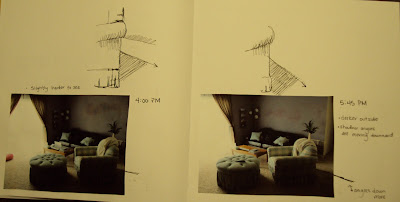After reading three different articles on the impacts of light towards a person’s health, I was surprised to discover some new information. One, I did not realize that coming in contact with lighting during the night can increase the risk of breast cancer and other forms of cancer. Two, I discovered that daylight savings time has an effect on a person’s health. I knew that daylight savings can cause a “jet-lag” type of effect but did not realize that the human body has an internal clock that has not been adjusted to the new light patterns.
As a designer, the articles helped me realize how important lighting can be in an interior space. This is because the type of lighting and the intensity of lights can affect the body’s normal patterns and health. As stated in the article “Influence of Architectural Lighting on Health,” “ exposure to normal circadian light patterns for significant periods of time may lead to negative health effects.” Therefore: as a designer, it is important to design lighting in a space that can be adjusted easily. Windows also need to be in specific locations so that daylight can enter and also be covered when needed.
Listed in one of the articles (pg 3) are examples and hints that designers can do to make lighting a positive experience on health. Some of the ones that stood out as particularly important include having light that can be adjusted, can be used as an egress in emergencies, and does not contain over exposure. It is crucial for designers to address these things because lighting can affect the way a space looks and feels.
SAD, which stands for Seasonal Affective Disorder, is linked to ineffective exposure to daylight. As a designer this can be addressed with the positioning of windows. Windows must be located in at least one or two rooms within a building so that people can receive sunlight. Also, when daylight recedes, the changing levels of melatonin (pg 1, influence of architectural lighting on health) occur and promote sleepiness. Therefore, in certain locations the interior space should accommodate darkness, or allow daylight to be covered in order for the body to function properly.
Artificial lighting also effects health. In one of the articles, research on the circadian rhythm shows that red, blue, white, and yellow light exposure can effect the body’s melatonin and influences physiological, mental, and behavioral responses.
Last thing I discovered in the third article that is important to remember when designing a space, is the idea that breast cancer is increased when a person or persons is exposed to artificial light during the night. Designers have placed outdoor lighting in busy areas but do not realize that this exposure can increase the risk of cancer. One thing that we could try to change as designers, is allow lighting to be adjustable and increase with the amount of people present in the area.
A hormone that decreases the growth of tumors in the brain is affected negatively during the night if light exposure occurs. When light is needed after daylight has gone away, it might be possible to create artificial lighting that can diminish slightly so overexposure doesn’t become a health issue.
In future design projects that are directed towards light; there are a few important factors that need to be looked at. The lighting should be easily adjusted for different needs. This can be done by provided different options within the space. For example, having ambient lighting can be good during the day and during the night, but focal point lighting should be an option as well.
Also, window location would be a crucial part of the design process. The designer should pay close attention to the orientation of the building or space. The sun rises in the east and sets in the west; therefore windows should be placed where one can receive lots of daylight or only small amounts depending on what the place is being used for at the time.
Last, safety when designing light in a space should be looked at. Lighting towards and exit or window helps a person see if an emergency should happen. I think that very low focal point lighting should be used for this purpose. This is because when a person has to escape for any reason, adjusting to a bright light source may be difficult.
Designers are given a huge burden when designing lights. They must first decide who will be using the space, and then figure out what type of artificial and natural lighting should be used in a way that will not negatively affect human health. In my opinion this is the most important part of designing a space because it has an affect on our mood, health, and many other factors.















 The space that we evaluated is the lounge area on the second floor of gatewood. It is used as an area to relax, study, watch television, and wait between class. The lighting in the space is very dim with exterior spotlights intended for artwork from the art department. The lounge is medium size with only a few tables which makes it seem spacious. It is a public space, but more intimate in scale because of the small tables located around the room. After evaluating the room, our overall impression of the space is lacking of emotion and bland.
The space that we evaluated is the lounge area on the second floor of gatewood. It is used as an area to relax, study, watch television, and wait between class. The lighting in the space is very dim with exterior spotlights intended for artwork from the art department. The lounge is medium size with only a few tables which makes it seem spacious. It is a public space, but more intimate in scale because of the small tables located around the room. After evaluating the room, our overall impression of the space is lacking of emotion and bland.
